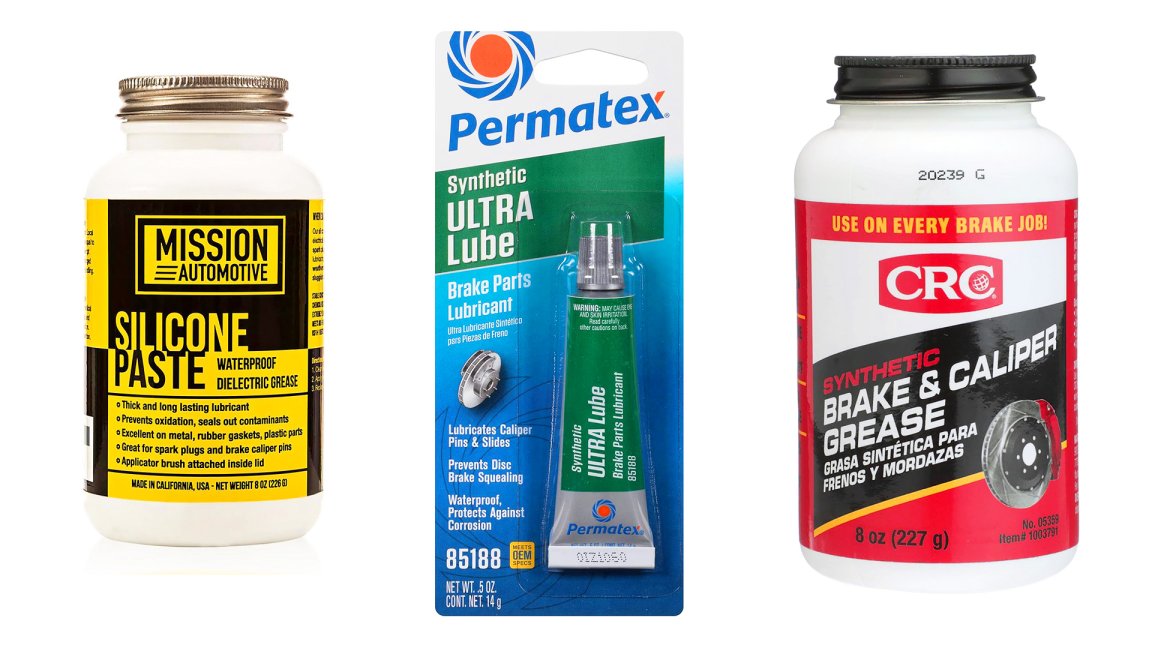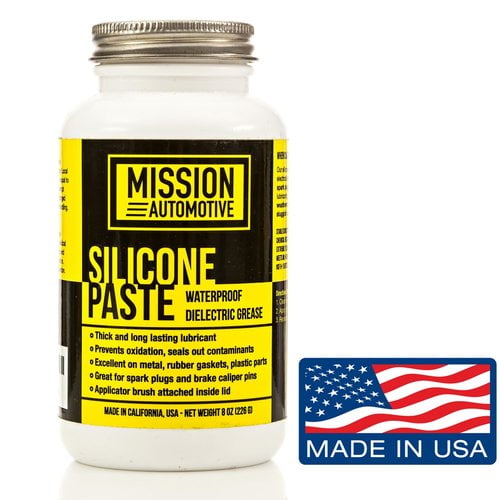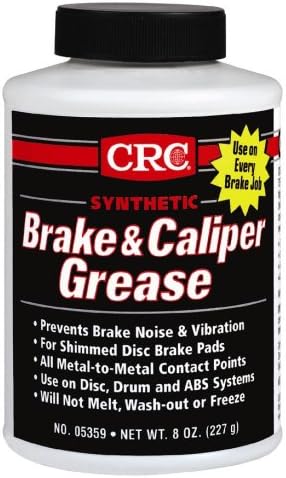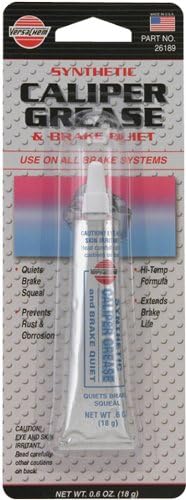We may earn revenue from the products available on this page and participate in affiliate programs. Learn more ›

Brake caliper grease helps extend the life of your brakes by properly lubricating all of its components to avoid brake dust buildup, squeaking, and malfunction due to heavy wear and tear. Brake caliper grease varies in terms of consistency, noise/vibration reduction, operating range, and compatible connections to rubber, plastic, and metal. There’s an immense amount of options out there, too, so it can be tough choosing the right one.
Which is why you should read through our handy guide! Learn more about the best brake caliper greases, including our top recommendations and shedding more light on what you need to know about them.
Summary List of Best Brake Caliper Grease
- Best Overall: Mission Automotive Silicone Paste Waterproof Dielectric Grease
- Best Value: Permatex Ultra Disc Brake Caliper Lube
- Best High-End: CRC Brake And Caliper Synthetic Grease
- Honorable Mention: Versachem Synthetic Caliper Grease
Our Methodology
After combing the internet for the best tips of brake grease useage, as well as factoring in our own DIY wrenching knowledge, we came up with this list of products to help you on your way to finding the best brake caliper grease. Not all options out there are created equal, but these are among the top options for their respective price points. For more on how we select products, please read this.
Best Brake Caliper Grease: Reviews & Recommendations
Best Overall: Mission Automotive Silicone Paste Waterproof Dielectric Grease
Pros
- Very high temperature tolerance
- Made in USA
- Very versatile
Cons
- Higher price
- Thicker formula can be difficult to apply
This silicone-based compound offers low viscosity and excellent dust resistance. Combined with polydimethylsiloxane (PDMS), a silicon-based organic polymer, it can be used across countless applications from automotive to industrial. This highly rated product is equally effective and safe on all types of materials, including brake calipers, pads, and other internal/external components such as rubber gaskets, hoses, and O-rings. Kudos for its high-temperature resistance (-40 to +500 degrees Fahrenheit)
Be sure to use gloves or the attached brush when applying Mission Automotive Dielectric Grease/Silicone Paste/Waterproof Marine Grease, as its excess thickness makes it difficult to remove and apply without them. Note that many online reviews have blasted the attached brush for loose bristles and the lack of a straight option.
Best Value: Permatex Ultra Disc Brake Caliper Lube
Pros
- Great price
- Maintains good viscosity
- Takes very little for effectiveness, so it lasts
Cons
- Doesn’t cut down noise by much
For anyone who doesn’t want to buy brake caliper grease in bulk, our best value option, the Permatex Disk Brake Caliper Lube, may be a great pick for you. It’s a green, synthetic grease that comes in a 0.5 ounce tube. The fluid is formulated to maintain the lubrication of the caliper pins and slides.
This product is designed to be non-melting, meaning that it will last through adverse braking conditions and promote the longevity of your brake calipers. It also maintains a consistent viscosity even under extreme heat or cold conditions. This means that you may not have to worry about regreasing your calipers as often as you regularly would.
While it’s a great product, 0.5 ounces is only enough to cover one brake caliper. Also, it’s not safe on rubber and, therefore, you should only apply it on the metal parts. In addition, it’s not the best for dampening brake noise.
Best High-End: CRC Brake And Caliper Synthetic Grease
Pros
- Slightly higher price
- Very long-lasting formula
- Brilliant lubrication properties
Cons
- A little higher in price than other options
Don’t let the 1980s-looking bottle fool you. CRC Brake Caliper Synthetic Grease is a very formidable option. Its calling card is its unique molybdenum, PTFE, and graphite blend, which works very well with all types of brake components, including disk brake pads, pivot pointers, self-adjusters, O-rings, and calipers. It is also known for its durability ( -40 to 400 degrees Fahrenheit temperature range), lasting for much longer than standard grease.
The CRC Brake Caliper Synthetic Grease is highly rated and is given good reviews for its value, thickness consistency, and generous 8-ounce portion size.
Honorable Mention: Versachem Synthetic Caliper Grease
Pros
- Convenient brush applicator
- Great for cutting down noise
- Good temperature threshold
Cons
- Not as high of a temperature threshold as other formulas
- Can gum up components
The Versachem 26080 is a great grease for anyone looking to dampen brake noise and prolong brake life. It’s formulated with pure synthetic oils and has additives to prevent rust, corrosion, and oxidation. It also includes a sear-stable thickener that helps to improve its high temperature tolerance to provide maximum protection to the applied surface.
The grease comes in an 8-ounce bottle with a convenient brush applicator on the lid. It has a working temperature of -5 to 400 degrees Fahrenheit. The grease lasts longer on a disk brake caliper but it can also be used on spark plug boots, battery terminals, valves, and bushings.
Naturally, this grease has a few drawbacks, too. For one, it has a low operating temperature in comparison to other synthetic greases and, as a result, has a tendency to run hot. It can also get too gummy in the brake system and may need to be washed out to prevent more dust from sticking on the brake pads.
Our Verdict on the Best on Brake Caliper Grease
If you want the best best overall product to get the job done, check out Mission Automotive Silicone Paste Waterproof Dielectric Grease. For a little more value for your money, you can’t beat Permatex Ultra Disc Brake Caliper Lube. Finally, to go all out, check out CRC Brake And Caliper Synthetic Grease.
Tips
- Be sure to apply the proper amount of lube when you’re working on the brakes. Using either too much or not enough will adversely affect the effectiveness and/or lifespan of the brakes.
- Opt for silicone-based brake caliper grease over other formulas. Silicone grease offers outstanding viscosity and keeps plastic and elastic parts safe, unlike hydrocarbon-based oils. It holds the highest temperature resistance (high-temperature resistance (-40 to +500 degrees Fahrenheit) of all types.
- Upon every tire rotation, use an air compressor to clear brake dust and debris off of your brakes. This makes lubricant easier to apply and creates additional stickiness.
- Keep brake caliper grease stored in a cool and dry location with temperatures ranging between 46 to 82 degrees Fahrenheit for the best results.
- Watch out for synthetic formulas. Some synthetic formulas do not work well with rubber boosts and bushings.
- Avoid low viscosity formulas. Low viscosity formulas can drip or run, loosening off of your brake parts and generating wear and tear over time.
- Watch your driving conditions. If driving in colder climates, opt for lubricating your brake caliper pins at least quarterly or depending on driving conditions. If not, expect faster wear and tear on your brakes due to increased friction between your rotor and brake pads. Any excess corrosion is a surefire sign your brake caliper pins need lubrication or replacement.
- Look for brake caliper grease with an extreme working temperature range (e.g. -40 to +500 degrees Fahrenheit). Lower quality brake caliper grease will cause your components to dry out or lubricate to freeze or melt. Watch for non-freeze and non-melt formulas.
FAQs on Brake Caliper Grease
You’ve got questions. The Drive has answers.
First, remove rust from the caliper brackets using a wire brush or other tool. Clean or replace hardware, and lubricate any of the metal to rubber friction points.
The brakes on your car can get extremely hot, particularly when braking hard or braking repeatedly. Some general-purpose lubricants don’t hold up in these conditions. You need high-temperature grease that can take the heat and won’t damage rubber or plastic components.
White lithium applies to drum brake hardware and backing plates; however, it is a low-temperature grease, so it shouldn’t be on front disc brakes.
Our recommendations on the best brake calipers run the gamut in terms of price point, consistency, noise/vibration reduction, operating range, and compatible connections to rubber, plastic, and metal.
Not greasing caliper pins could result in sustained wear and tear over time, causing uneven brake pad wear, poor brake-to-rotor contact, and sticking slide pins that cause excessive heat buildup. Excess brake dust buildup can also result.
We highly recommend lubricating your caliper slide pins at least twice a year or as needed based on driving conditions. Colder climate drivers may benefit more for more frequent lubrication.






